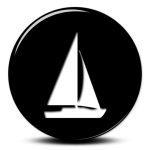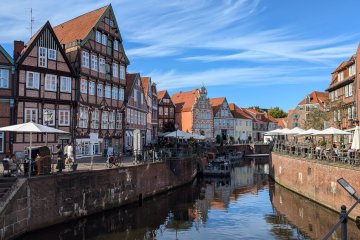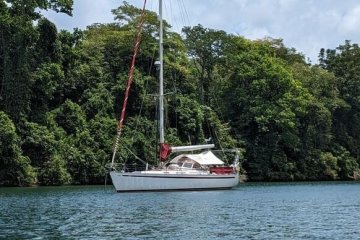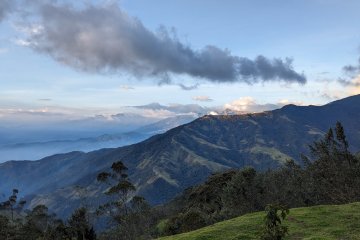After shopping was finished the time had finally come and we were able to leave Cartegena and set sail. As the weather window was not so good we decided to anchor in a lagoon off the island of Baru for a few more days.
The entrance to the lagoon is quite shallow and we ran aground when we left, fortunately it was only on mud.
With an anchor stop off Isla Fuerte, we sailed with a good wind of between 15kn – 20kn non-stop to Sapzurro. It was the best sailing trip for a long time!
Sapzurro is the last town on the Colombian side and the bay is beautiful. In the morning we could hear Howler monkeys calling in the rain forest.
Unfortunately in the morning we discovered that our “Navtec” hydraulic pump for the rigging was leaking. All the oil ended up in our locker over our sailing jackets. Really annoying!
After some research John found a Navtec hydraulic dealer in Colon so we have the option to have it repaired there.
Just two bays further on is the small, inconspicuous town of Olbadia. Here we were able to check into Panama within two hours.
First to immigration where two rather bored officials took photos of us and gave us our stamp. Then to the Maritime office where we were warmly welcomed by an older man and had to sign a multitude of papers. Finally we got our cruising license and had to pay 200 dollars. The last stop is the military post where the papers are copied and passed back to us (with more stamps…)
The landscape immediately changes in Panama to dense green impenetrable rain forest and villages made of bamboo poles.
In the first anchorage (Puerto Escocés) it was almost dark when we arrived and there was no one there except a few “Guna” Indians in their “Ulu” (a dugout canoe).
The next day we continued to Isla Pinos where we spent two good days with David (a local guide) and we also met two very nice Belgian couples with their boats.
David is a young man from the village who earns money as a tourist guide through his village and will cook for you if you like.
Without a guide you feel very foreign in a Guna village like this and you have the feeling that you are an intruder. The women are very shy and don’t like to be photographed.
David told us that each village has a chief (Saila) who takes care of all the problems of the villagers and give news. This happens in weekly meetings in the Congresso.
Most of the time the meeting is a song sung by the chief and two so-called translators who tell the villagers everything they need to know. They are also responsible for random loud shouts to stop people falling asleep!
The Guna culture is matriarchal, the women choose their husbands and the men then move into the woman’s house.
The huts are made of simple bamboo poles with roofs made of palm fronds. Several generations often sleep and cook together in one hut. There is some furniture, such as small tables and plastic chairs and, of course, hammocks.
In most anchorages the chief comes in his ulu and asks for 10 dollars. You are then allowed to stay there for a month. You are supposed to ask the chief if you can stay or not, but generally this is no longer required.
The next place where we anchored all by ourselves was Mamitupu. A charming little fishing village.
Almost every morning the Gunas would come to our boat in their ulus and offer us fruit or fish and the children asked for sweets. We quickly gave away all our gifts of reading glasses and sweets we bought and would have needed many more.
We also gave the children coloured pencils and pens – it was strange to see that many of the youngsters didn’t understand how to press the button on ball-point pen to make the “inky bit” appear. Those that knew were instant heroes!
The children learn very early on how to balance in these small ulus and also how to catch fish with nets.
There are also some Albinos in the villages who naturally have a huge problem with the sun. That’s why they always ask for sun cream.
No foreigners are allowed to marry in Guna Yala and no land may be sold to foreigners. Foreigners are also not allowed to just take coconuts from the islands. This is because it is they are property of the Guna Indians and the coconuts have a value. Many are simply sold to the sailors!
The Guna Indians are master sailors in these small canoes and with a simple sail frequently travel from one island to another.
We also found a guide called “Pablo” in Mamitupu. We were able to communicate with Pablo in English, as he was once married to an English woman and lived there for a few years.
The visit to his village ended at his hut and we got to know his very healthy 94-year-old mother. The Gunas often live to a very old age and are extremely fit. Of course, this is not surprising, because they have hardly any stress and eat a healthy diet. We have not seen any overweight Gunas here on the coast or on the San Blas Islands.
As a gift John gave him a solar panel and regulator as their only source of electricity is solar energy.
We met up with our Belgian friends again in the next anchorage and sailed on in a group of three.
Navigating in San Blas is sometimes very challenging and it is nerve-wracking when reefs or individual rocks appear. The “Panama Cruising Guide” by Eric Bauhaus is a great help and almost a must. It is an incredibly detailed navigation book and amazingly precise with useful waypoints to assist in navigation.
Further on when anchored near Isla Mono, a whole school of dolphins visited us in the morning. We continued to the next anchorage Snug Harbour.
During the night we had an incredible thunderstorm with lightning everywhere in the bay and quite high wind speeds. A bit scary! John let out our entire anchor chain of 90 meters during the night just to be sure we didn’t drag.
Behind Isla Tigre we anchored with three other boats surrounded by reefs.
Here too we visited the village and once again the children came up to us with great curiosity. There is also a somewhat larger school here.
The last place was Nargana before heading to the San Blas Islands. This small island town no longer follows the strict rules of the Guna community and the women tend to wear more western style clothing.
Here we stocked up on fruit and other food, as far as it was available. The water was very murky so not really suitable for swimming and we anchored in front of the town. We were surrounded by mangroves and unfortunately also a huge area with rubbish piled up, mainly plastic waste.
There are also said to be crocodiles here although we didn’t see any.
We also explored the Rio Diablo by dinghy but unfortunately still didn’t see any crocodiles there either, instead we saw a beautiful river landscape half in the jungle with hidden fields of coconut palms and sugar cane.
The Guna Indians go here with their ulus because there is drinking water in the upper part of the river. The water is very clear,cold and not salty.
And after sailing 10 miles further north, we reach the Cocos Banderos archipelago. Four really picture-postcard little islands with beautiful sandy beaches,
but unfortunately also a lot of plastic rubbish that has accumulated on the side of the islands. There is no way for the islanders to dispose of the rubbish here – at night they burn it and you can smell the burning plastic.
Here we also saw the nurse sharks for the first time. They look quite inconspicuous but can be quite large. I had to get used to them while snorkeling, even though they are supposed to be harmless.
All in all, it was a great anchorage but only if the wind wasn’t blowing from the NE and wasn’t too strong.
From here we sailed to the Hollandes Cays, which are about 7 miles further north and therefore the furthest islands from the mainland.
There are some wonderful anchorages here with great snorkeling spots that we really enjoyed. On the main island there is a small restaurant run by Ibin, who prepares an excellent menu of spiny or “Rock” lobster or fish for 20 dollars.
Here the the “Supermarket boat” comes every week with all kinds of fruit, vegetables, tinned food, beer and wine.
Of course the Kuna locals frequently pass by trying to sell you lobster, fish and “Molas”. A “Mola” is a decorative cloth worn by the women as a skirt or shirt. It seemed to us that whilst some of them were pretty, many seemed cheaply made.
One popular seller of “Molas” is a character known as “Mola Lisa”. He is actually a transvestite and is well known throughout the San Blas!
We also met our Italian friends Freddy and Anita here again. For the first time it was a bit crowded with boats.
Unfortunately we had a problem with our generator and we suddenly had seawater in the engine room.
John then spent the whole next day repairing the generator by replacing the seal and the impeller on the water pump and the exhaust hose which was the cause of all the water.
The generator is 19 years old and the seal was only replaced by John at the beginning of the year. But that wasn’t all, the next day our water maker started to make ominous noises. This could be a real problem because then we have no more drinking water. There are very few places to get water in the San Blas islands. In fact the Kuna frequently come and ask us for water.
Typically the tank was almost empty, although the second tank had about 100 litres in it. At the time we had no possibility to repair the motor and have to wait until we are in Shelter Bay Marina in 2 weeks.
So we hope that the motor will hold out until then and continue to produce drinking water for us. Our Belgian friends were kind enough to offer us drinking water, but then they would have to run their water maker more often too….
Then there was problem with our outboard motor and our spirits plummeted.
But that’s boat life, half the time is spent repairing something and getting spare parts is not always easy. From time to time we even consider selling the boat if there are too many repairs.
We are now planning the Panama canal transit for the end of February 2025, but that also changes as problems with El Niño and global warming affect the canal as there is not enough water to operate the locks.
Even here in the San Blas Islands, the locals tell us that entire islands are disappearing due to rising water levels.
Behind the island of Salardup we had a lovely, relaxed Christmas with our Belgian friends Ann & Thomas.
Here too there are wonderful snorkeling spots where we saw eagle rays and nurse sharks. The Gunas take care of our dietary needs by always offering us lobsters and giant crabs.
Once a week a supply boat comes by with vegetables, fruit and drinks. It’s not cheap, but it’s the only option.
Approaching Panama was quite exciting as there were many ships waiting outside for their turn to transit the canal. We had to call “Christobal Signal Station” on the VHF radio to make sure it was OK for us to proceed.
From there we continued across the outer part of the canal and into the very protected Shelter Bay Marina.
As we entered the bay we could see the first set of locks, Gatun Locks that take you to Gatun Lake. This is the place that all sailors have heard about – the entrance to the Panama Canal, the Gateway to the Pacific. It was quite a moment!
Now we’ve been at Shelter Bay Marina for two weeks now and are taking care of all the repairs. The motor of our water maker has already been repaired as well as the hydraulic pump of our rigging.
But at the moment we have the feeling that we want to keep sailing and simply have to invest a little more money into the boat before we head for the Pacific.
Due to the tense global situation of wars, etc., we really appreciate the fact that we can be here and still experience one of the last paradises on earth.
Here in the marina we are right next to the jungle and are woken up in the morning by the Howler Monkeys. The morning swim in the pool is also very refreshing.
We will put Maya ashore here over the hurricane season when we go back to Hamburg and the UK for 3 months.



